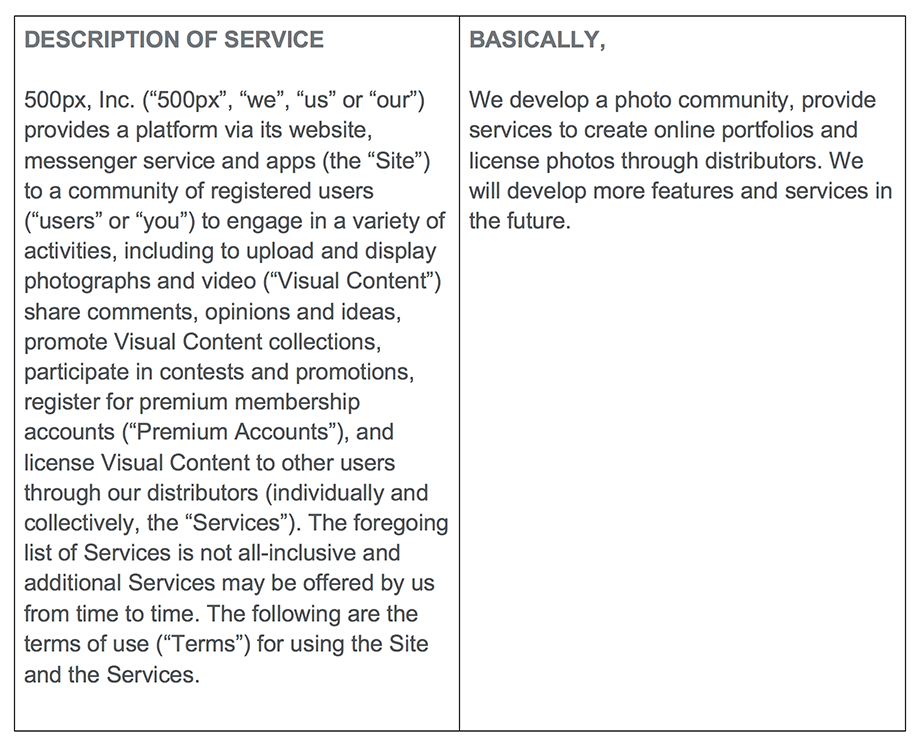How to Write a Terms of Service Agreement (That Doesn’t Suck)
First, know why you might want or need one.
Unlike a privacy policy (which is required by law if you collect any user data), a terms of service (TOS) page, for many companies is likely not a requirement. So, why muddy your site with a boring and perhaps unnecessary TOS? Well, first of all, because, like eating your vegetables, it’s good, healthy business practice. And, we believe, an opportunity to create a differentiating and positive user experience.Your published terms of service are the publicly stated contractual terms between you and the user. On the chance that a user or customer takes you to court over their experience on your site, a well-designed TOS could potentially limit your liability. So, assuming you feel the need, how can you create a TOS that is as experientially enjoyable as it is protective? Read on.
Be upfront, transparent and honest.
This shouldn’t require its own paragraph, but if you’ve ever read other TOS pages, you’ll already know it’s been regarded as optional by a large group of corporate attorneys. In fact, there is an entire web site (https://tosdr.org/) dedicated to decoding the legalese. So, why would impenetrable TOS’s exist at all?
First: fear. Some companies are afraid that if users really understood how their data might be used/leveraged/monetized they’d be frightened away. However, when you poll most Millennials and Gen Z’ers, they are actually less afraid of monetization schemes (they expect them) than they are about intentionally misleading terms of service (sadly, also expected).
Second: a lot of lawyers are just terrible writers. There are also lawyers who are terrible writers who think they are great writers. The latter we’re not sure anyone can help with.
Be as specific as necessary. No more, no less.
It seems, in most TOS, the default for dealing with future ambiguity is to obfuscate or add verbiage to account for every eventuality. Either way, it’s a tactic increasingly seen by your users as deceptive. So, while you may believe you’re protecting your business options, legally, you may be harming your long-term business relationships with customers. The photo sharing site 500px provides the “belt and suspenders” approach to this issue by providing their TOS in a two column format. The first column is the, “legalese,” and the second is what they title, “basically.” The opening paragraph:
Write it for a really hip six-year-old.
A recurring bit of advice on this blog is that we should all acknowledge Einstein’s most famous law—no not relativity—the one that posits if you can’t explain it to a six-year-old, you don’t truly understand it yourself. Your TOS is the perfect place to prove you too understand what you’re asking of your users. Tumblr famously proves they do, translating some of the more dense legalese into easily digestible and entertaining chunks, like:“You have to be the Minimum Age to use Tumblr. We're serious: it's a hard rule. “But I’m, like, almost old enough!” you plead. Nope, sorry. If you're not old enough, don't use Tumblr. Ask your parents for a Playstation 4—or try books.”
Just remember, your corporate counsel isn’t wrong.
As much as users don’t like reading or agreeing to a TOS, it’s unlikely they will go away anytime soon. Too much of what transacts on the web these days involves some transfer of rights. And while your corporate attorney is right when he or she pushes back on what your TOS needs to cover, it’s also true that there are great examples of how what could be an off-putting, intimidating, or flat out disregarded user experience could actually enhance users’ affinity for your site or brand.

